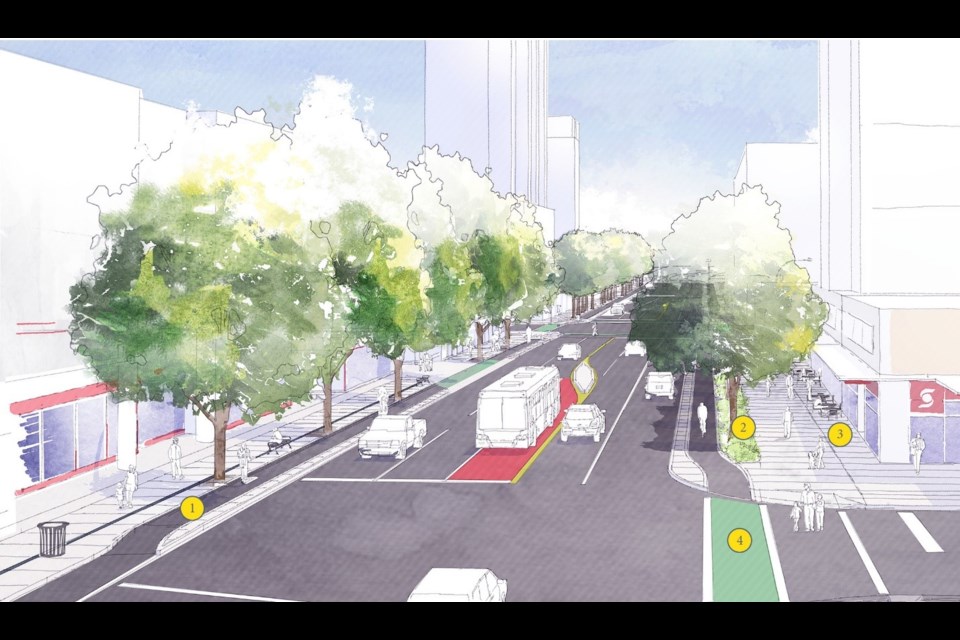The Esplanade corridor will be getting a complete makeover to create a more comfortable and safe experience for all users – with a design that’s been labelled “a street for the 21st century.”
Construction on the Esplanade Complete Streets project, which has been in the works since mid-2020, will get rolling this summer after City of North Vancouver council gave the green light for staff to move ahead with plans at its June 21 general meeting.
Aligning with the city’s Safe Mobility Strategy, the goal of the $7.5-million project is to provide more active and sustainable ways for people to move to, from and within the city safely and efficiently, while maintaining the existing road capacity for transit, trucks and passenger vehicles. It also aims to provide good access to local businesses and create a street that feels vibrant and welcoming.
“For far too long, our community has been designed for automobiles, and we are looking at ways and means in which we can utilize public road space for all uses,” Mayor Linda Buchanan said, speaking at the general meeting.
“Esplanade is a very complex stretch of road because its uses are not just for pedestrians and movement of public transportation, but it's also goods movement and part of the trade-enabling lands. It has a lot of uses, but it is part of a very vibrant neighbourhood as well. So, we want to make sure that everything we do there is supporting people and the movement of people in whichever mode that they're moving through.”
After an intensive community consultation period last November, staff found that “safety was identified as the single most important issue to be addressed when reimagining the corridor” and they have spent the last few months designing a plan to address the community’s concerns.
Improvements to create a better pedestrian experience
The project will improve the pedestrian experience by creating wider sidewalks, adding more seating and lighting to provide places to rest or socialize and creating safer driveway crossings by raising the areas to sidewalk height. More trees will also be planted to create separation between people moving at different speeds.
Through consultations, the city also heard that community members didn’t feel comfortable crossing the street. As part of the upgrades, larger waiting areas will be created at intersections to give people more space, advanced walk signals will be installed, and corners will be tightened at intersections, so drivers have to slow down when turning. The city will also be introducing a protected intersection design at Chesterfield.
For cyclists and rollers, the city will be separating mobility lanes from vehicles, parked cars, and sidewalks and creating safe passing space within the mobility lanes.
The new design will also improve accessibility at existing transit stops. Plus, bus stops will be designed to reduce conflicts between the sidewalk and mobility lanes.
The city has taken traffic flow into consideration, maintaining the two vehicle lanes in each direction on Esplanade and adding left turn lanes at St. Georges. Forbes will also be reduced to one lane southbound from Third Street to provide safe separated space for people walking and cycling, and left turns at First and Second streets will be restricted from 7 a.m. to 7 p.m. to keep the single southbound travel lane flowing.
The project will also address business owners’ concerns surrounding curbside access by providing dedicated areas for commercial loading and passenger pickup and drop-off and setting time limits for curb spaces to encourage turnover, among other changes.
A 'defining moment' for the city
Councillors voted unanimously in support of the project going out to tender for construction, speaking positively about the changes at the June 21 meeting.
“Given the Shipyards along with the Quay, the museum, Polygon Gallery, having become a destination place, this project is critical in getting it right to further support that vibrancy of the area, while at the same time maintaining that functionality of Esplanade being the main transit and trucking corridor,” noted Coun. Angela Girard.
Coun. Tony Valente labelled the project a “defining moment for our city.”
“One of the greatest powers that we have as a council is how we use our streets,” he said. “We have a goal and our strategic plan about being the healthiest small city, and it starts on our streets.
“This is not about some bike lanes; this is about the quality of life for people and businesses. I think being on council, one of the things that we have to do is address the needs of today and at the same time plan for the future.
“I believe that this new design is a street for the 21st century.”
Coun. Jessica McIlroy added the project also offered great benefits that reflected the city’s climate and environment strategy, including encouraging a shift from emissions intensive modes of transport to more active options and increasing green space and tree coverage.
Staff noted in the report that the cost to deliver on the project’s design goals came in “higher than anticipated at the outset of the project – in part due to COVID-19 related construction cost escalation.”
The project is being funded through a number of avenues, including $3.1 million from the 2021 capital budget, $1.795 million from TransLink and $1.489 million from reallocated funds from projects with similar objectives. Further funding needed will be incorporated into the 2022 capital plan for council’s consideration.
The project team says the reconstruction of the corridor is anticipated to take 10 months depending on weather conditions and with a pause of construction during the December holiday season.
See a detailed design of the upgrades.
Elisia Seeber is the North Shore News’ Indigenous and civic affairs reporter. This reporting beat is made possible by the Local Journalism Initiative.



